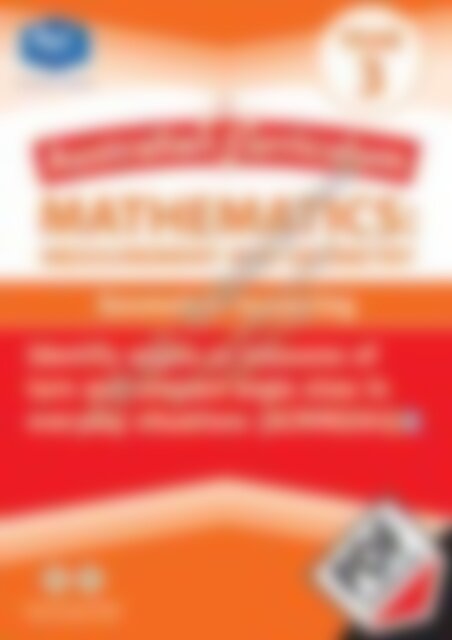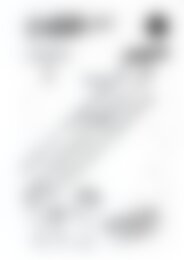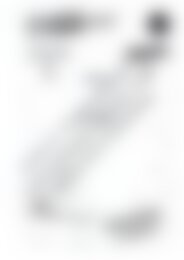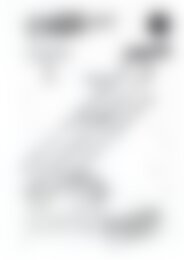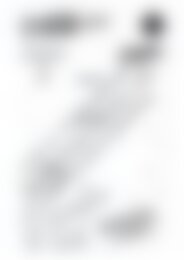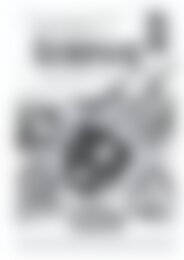RIC-20153 ACM Measurement and Geometry (Yr 3) Geometric reasoning
Create successful ePaper yourself
Turn your PDF publications into a flip-book with our unique Google optimized e-Paper software.
©R.I.C. Publications<br />
Low Resolution Images<br />
Display Copy
Australian Curriculum Mathematics<br />
resource book: <strong>Measurement</strong> <strong>and</strong> <strong>Geometry</strong><br />
(Year 3)<br />
Published by R.I.C. Publications ® 2013<br />
Copyright © Linda Marshall 2013<br />
<strong>RIC</strong>– <strong>20153</strong><br />
Titles in this series:<br />
Australian Curriculum Mathematics resource book:<br />
<strong>Measurement</strong> <strong>and</strong> <strong>Geometry</strong> (Foundation)<br />
Australian Curriculum Mathematics resource book:<br />
<strong>Measurement</strong> <strong>and</strong> <strong>Geometry</strong> (Year 1)<br />
Australian Curriculum Mathematics resource book:<br />
<strong>Measurement</strong> <strong>and</strong> <strong>Geometry</strong> (Year 2)<br />
Australian Curriculum Mathematics resource book:<br />
<strong>Measurement</strong> <strong>and</strong> <strong>Geometry</strong> (Year 3)<br />
Australian Curriculum Mathematics resource book:<br />
<strong>Measurement</strong> <strong>and</strong> <strong>Geometry</strong> (Year 4)<br />
Australian Curriculum Mathematics resource book:<br />
<strong>Measurement</strong> <strong>and</strong> <strong>Geometry</strong> (Year 5)<br />
Australian Curriculum Mathematics resource book:<br />
<strong>Measurement</strong> <strong>and</strong> <strong>Geometry</strong> (Year 6)<br />
All material identified by is material subject to<br />
copyright under the Copyright Act 1968 (Cth) <strong>and</strong> is owned<br />
by the Australian Curriculum, Assessment <strong>and</strong> Reporting<br />
Authority 2013.<br />
For all Australian Curriculum material except<br />
elaborations: This is an extract from the Australian<br />
Curriculum.<br />
Elaborations: This may be a modified extract from the<br />
Australian Curriculum <strong>and</strong> may include the work of other<br />
authors.<br />
Disclaimer: ACARA neither endorses nor verifies the<br />
accuracy of the information provided <strong>and</strong> accepts no<br />
responsibility for incomplete or inaccurate information. In<br />
particular, ACARA does not endorse or verify that:<br />
• The content descriptions are solely for a particular year<br />
<strong>and</strong> subject;<br />
• All the content descriptions for that year <strong>and</strong> subject<br />
have been used; <strong>and</strong><br />
• The author’s material aligns with the Australian<br />
Curriculum content descriptions for the relevant year<br />
<strong>and</strong> subject.<br />
You can find the unaltered <strong>and</strong> most up to date version of<br />
this material at<br />
http://www.australiancurriculum.edu.au/<br />
This material is reproduced with the permission of ACARA.<br />
Copyright Notice<br />
A number of pages in this book are worksheets.<br />
The publisher licenses the individual teacher who<br />
purchased this book to photocopy these pages to h<strong>and</strong><br />
out to students in their own classes.<br />
Except as allowed under the Copyright Act 1968, any<br />
other use (including digital <strong>and</strong> online uses <strong>and</strong> the<br />
creation of overhead transparencies or posters) or any<br />
use by or for other people (including by or for other<br />
teachers, students or institutions) is prohibited. If you<br />
want a licence to do anything outside the scope of the<br />
BLM licence above, please contact the Publisher.<br />
This information is provided to clarify the limits of this<br />
licence <strong>and</strong> its interaction with the Copyright Act.<br />
For your added protection in the case of copyright<br />
inspection, please complete the form below. Retain this<br />
form, the complete original document <strong>and</strong> the invoice<br />
or receipt as proof of purchase.<br />
Name of Purchaser:<br />
Date of Purchase:<br />
Supplier:<br />
School Order# (if applicable):<br />
Signature of Purchaser:<br />
©R.I.C. Publications<br />
Low Resolution Images<br />
Display Copy<br />
Internet websites<br />
In some cases, websites or specific URLs may be recommended. While these are checked <strong>and</strong> rechecked at the time of publication,<br />
the publisher has no control over any subsequent changes which may be made to webpages. It is strongly recommended that the class<br />
teacher checks all URLs before allowing students to access them.<br />
View all pages online<br />
PO Box 332 Greenwood Western Australia 6924<br />
Website: www.ricpublications.com.au<br />
Email: mail@ricgroup.com.au
AUSTRALIAN CUR<strong>RIC</strong>ULUM MATHEMATICS<br />
RESOURCE BOOK:<br />
MEASUREMENT AND GEOMETRY<br />
(YEAR 3)<br />
Foreword<br />
Australian Curriculum Mathematics resource book: <strong>Measurement</strong> <strong>and</strong> <strong>Geometry</strong> (Year 3) is one in a series of seven teacher resource books that support<br />
teaching <strong>and</strong> learning activities in Australian Curriculum Mathematics. The books focus on the measurement <strong>and</strong> geometry content str<strong>and</strong>s of the<br />
national maths curriculum. The resource books include theoretical background information, resource sheets, h<strong>and</strong>s-on activities <strong>and</strong> assessment<br />
activities, along with links to other curriculum areas.<br />
Format of this book ................................................. iv – v<br />
Using units of measurement .................................... 2–29<br />
• UUM – 1<br />
Measure, order <strong>and</strong> compare objects using familiar metric units of<br />
length, mass <strong>and</strong> capacity (<strong>ACM</strong>MG061)<br />
– Teacher information ............................................................................... 2–4<br />
– H<strong>and</strong>s-on activities ................................................................................. 5–7<br />
– Links to other curriculum areas ................................................................... 8<br />
– Resource sheets .................................................................................... 9–12<br />
– Assessment ........................................................................................ 13–14<br />
– Checklist ................................................................................................... 15<br />
• UUM – 2<br />
Tell time to the minute <strong>and</strong> investigate the relationship between units<br />
of time (<strong>ACM</strong>MG062)<br />
– Teacher information ........................................................................... 16–17<br />
– H<strong>and</strong>s-on activities ................................................................................... 18<br />
– Links to other curriculum areas ................................................................. 19<br />
– Resource sheets .................................................................................. 20–25<br />
– Assessment ........................................................................................ 26–27<br />
– Checklist ................................................................................................... 28<br />
Answers .................................................................................. 29<br />
Shape .................................................................... 30–45<br />
• Shape – 1<br />
Make models of three-dimensional objects <strong>and</strong> describe key<br />
features (<strong>ACM</strong>MG063)<br />
– Teacher information ........................................................................... 30–31<br />
– H<strong>and</strong>s-on activities ................................................................................... 32<br />
– Links to other curriculum areas ................................................................. 33<br />
– Resource sheets .................................................................................. 34–39<br />
– Assessment ........................................................................................ 40–43<br />
– Checklist ................................................................................................... 44<br />
Answers .................................................................................. 45<br />
Contents<br />
Location <strong>and</strong> transformation .................................. 46–71<br />
• L&T – 1<br />
Create <strong>and</strong> interpret simple grid maps to show position <strong>and</strong><br />
pathways (<strong>ACM</strong>MG065)<br />
– Teacher information .................................................................................. 46<br />
– H<strong>and</strong>s-on activities ............................................................................. 47–48<br />
– Links to other curriculum areas .................................................................. 49<br />
– Resource sheets .................................................................................. 50–56<br />
– Assessment ........................................................................................ 57–58<br />
– Checklist .................................................................................................... 59<br />
• L&T – 2<br />
Identify symmetry in the environment (<strong>ACM</strong>MG066)<br />
– Teacher information .................................................................................. 60<br />
– H<strong>and</strong>s-on activities .................................................................................... 61<br />
– Links to other curriculum areas .................................................................. 62<br />
– Resource sheets .................................................................................. 53–67<br />
– Assessment ........................................................................................ 68–69<br />
– Checklist .................................................................................................... 70<br />
©R.I.C. Publications<br />
Low Resolution Images<br />
Display Copy<br />
Answers .................................................................................. 71<br />
<strong>Geometric</strong> <strong>reasoning</strong> .............................................. 72–82<br />
• GR – 1<br />
Identify angles as measures of turn <strong>and</strong> compare angle sizes in<br />
everyday situations (<strong>ACM</strong>MG064)<br />
– Teacher information ........................................................................... 72–73<br />
– H<strong>and</strong>s-on activities ............................................................................. 74–75<br />
– Links to other curriculum areas .................................................................. 76<br />
– Resource sheets .................................................................................. 77–78<br />
– Assessment ........................................................................................ 79–80<br />
– Checklist .................................................................................................... 81<br />
Answers .................................................................................. 82<br />
Australian Curriculum Mathematics resource book: <strong>Measurement</strong> <strong>and</strong> <strong>Geometry</strong> (Year 3) R.I.C. Publications ® www.ricpublications.com.au iii
FORMAT OF THIS BOOK<br />
This teacher resource book includes supporting materials for teaching <strong>and</strong> learning in all sections of the <strong>Measurement</strong> <strong>and</strong> <strong>Geometry</strong> content str<strong>and</strong> of<br />
Australian Curriculum Mathematics. It includes activities relating to all sub-str<strong>and</strong>s: Using units of measurement, Shape, Location <strong>and</strong> transformation,<br />
<strong>and</strong> <strong>Geometric</strong> <strong>reasoning</strong>. All content descriptions have been included, as well as teaching points based on the Curriculum’s elaborations. Links to the<br />
proficiency str<strong>and</strong>s have also been included.<br />
Each section supports a specific content description <strong>and</strong> follows a consistent format, containing the following information over several pages:<br />
• teacher information with related terms, student vocabulary, what the content description means, teaching points <strong>and</strong> problems to watch for<br />
• h<strong>and</strong>s-on activities<br />
• resource sheets<br />
• a checklist<br />
• links to other curriculum areas<br />
• assessment sheets.<br />
Answers relating to the resource <strong>and</strong> assessment pages are included on the final page of the section for each sub-str<strong>and</strong> (Using units of measurement,<br />
Shape, Location <strong>and</strong> transformation, <strong>and</strong> <strong>Geometric</strong> <strong>reasoning</strong>).<br />
The length of each content description section varies.<br />
Related terms includes vocabulary associated<br />
with the content description. Many of these<br />
relate to the glossary in the back of the official<br />
Australian Curriculum Mathematics document;<br />
additional related terms may also have been<br />
added.<br />
Student vocabulary includes words which<br />
the teacher would use—<strong>and</strong> expect the<br />
students to learn, underst<strong>and</strong> <strong>and</strong> use—during<br />
mathematics lessons.<br />
The proficiency str<strong>and</strong>(s) (Underst<strong>and</strong>ing,<br />
Fluency, Problem Solving solving or Reasoning) relevant<br />
to each content description are listed. shown in bold.<br />
Teacher information includes background information relating to the content description, as well as<br />
related terms, desirable student vocabulary <strong>and</strong> other useful details which may assist the teacher.<br />
Sub-str<strong>and</strong>: Location <strong>and</strong> transformation— L&T – 1<br />
Create <strong>and</strong> interpret simple grid maps to show position <strong>and</strong> pathways (<strong>ACM</strong>MG065)<br />
RELATED TERMS<br />
Grid maps<br />
vever<br />
<br />
s.<br />
w<br />
(x<br />
ver(y<br />
Position<br />
T<br />
<br />
r<br />
s.<br />
Pathway<br />
T<br />
.<br />
Coordinates (Cartesian<br />
coordinates)<br />
<br />
repr<br />
<br />
<br />
<br />
<br />
<br />
<br />
r<br />
s.<br />
Student vocabulary<br />
coordinates<br />
north<br />
south<br />
east<br />
west<br />
clockwise<br />
anticlockwise<br />
right<br />
left<br />
forward<br />
backwards<br />
over<br />
under<br />
turn<br />
paces<br />
steps<br />
Notewe<br />
‘a<br />
<br />
’.<br />
TEACHER INFORMATION<br />
What this means<br />
<br />
<br />
<br />
’<br />
<br />
’<br />
’<br />
<br />
.<br />
<br />
<br />
<br />
Teaching points<br />
T<br />
e.<br />
<br />
<br />
.<br />
5<br />
<br />
4<br />
x<br />
y 3<br />
<br />
2<br />
<br />
1<br />
s.<br />
A B C D E<br />
What to look for<br />
<br />
.<br />
Students’<br />
<br />
<br />
.<br />
<br />
e.<br />
.<br />
<br />
yx<br />
.<br />
e.<br />
Proficiency str<strong>and</strong>(s):<br />
Underst<strong>and</strong>ing Problem solving<br />
F<br />
<br />
46 Australian Curriculum Mathematics resource book: <strong>Measurement</strong> <strong>and</strong> <strong>Geometry</strong> (Year 3) R.I.C. Publications ® www.ricpublications.com.au<br />
What this means provides<br />
a general explanation of the<br />
content description.<br />
Teaching points provides<br />
a list of the main teaching<br />
points relating to the content<br />
description.<br />
What to watch look for for suggests any any<br />
difficulties <strong>and</strong> misconceptions<br />
the students might encounter or<br />
develop.<br />
©R.I.C. Publications<br />
Low Resolution Images<br />
Display Copy<br />
Sub-str<strong>and</strong>: Location <strong>and</strong> transformation— L&T– 1<br />
HANDS–ON ACTIVITIES<br />
Grid moves game<br />
<br />
<br />
‘’.<br />
‘Move 2 squares to the left <strong>and</strong> up 3 squares’<br />
all<br />
students<br />
H<strong>and</strong>s-on activities includes descriptions or<br />
instructions for games or activities relating to the<br />
content descriptions or elaborations. Some of the<br />
h<strong>and</strong>s-on activities are supported by resource<br />
sheets. Where applicable, these will be stated for<br />
easy reference.<br />
1<br />
4<br />
2<br />
3<br />
<br />
<br />
<br />
Is the bookcase bigger or smaller<br />
than the easel? How much bigger is the teacher’s desk than any of the other desks?<br />
<br />
<br />
<br />
<br />
.<br />
<br />
<br />
<br />
yxy<br />
Where is the library? How would you get<br />
from the office to the car park? What are the coordinates of the art room? What is the shortest way to get from the canteen to<br />
the oval? What other ways could you get there?<br />
<br />
<br />
First to ten game: <br />
<br />
<br />
Australian Curriculum Mathematics resource book: <strong>Measurement</strong> <strong>and</strong> <strong>Geometry</strong> (Year 3) R.I.C. Publications ® www.ricpublications.com.au 47<br />
iv Australian Curriculum Mathematics resource book: <strong>Measurement</strong> <strong>and</strong> <strong>Geometry</strong> (Year 3) R.I.C. Publications ® www.ricpublications.com.au
(c)<br />
(e)<br />
(a)<br />
(d)<br />
(f)<br />
(b)<br />
No lines of symmetry<br />
There are<br />
an infinite<br />
number<br />
of lines of<br />
symmetry in<br />
a circle.<br />
No lines of symmetry<br />
(d)<br />
(a) (b) (c)<br />
(f)<br />
(h)<br />
(g)<br />
(e)<br />
(i)<br />
FORMAT OF THIS BOOK<br />
Links to other curriculum areas includes activities in other curriculum areas which support<br />
the content description. These are English, Information <strong>and</strong> Communication Technology, Health<br />
<strong>and</strong> Physical Education, History, Geography, the Arts <strong>and</strong> Languages). This section may list many<br />
links or only a few. It may also provide links to relevant interactive websites appropriate for the<br />
age group.<br />
Cross-curricular links reinforce the knowledge that mathematics can be found within, <strong>and</strong> relate<br />
to, many other aspects of student learning <strong>and</strong> everyday life.<br />
CONTENT DESCRIPTION: Create <strong>and</strong> interpret simple grid maps to show position <strong>and</strong> pathways<br />
Sub-str<strong>and</strong>: Location <strong>and</strong> transformation— L&T – 1<br />
Australian Curriculum Mathematics resource book: <strong>Measurement</strong> <strong>and</strong> <strong>Geometry</strong> (Year 3) R.I.C. Publications ® www.ricpublications.com.au 55<br />
Sub-str<strong>and</strong>: Location <strong>and</strong> transformation— L&T – 1<br />
Create <strong>and</strong> interpret simple grid maps to show position <strong>and</strong> pathways (<strong>ACM</strong>MG065)<br />
STUDENT NAME<br />
RESOURCE SHEET<br />
The new suburb<br />
Below is part of a map of a new suburb.<br />
The map is missing some details. Show:<br />
1. Traffic lights at the corner of White <strong>and</strong> Green Streets<br />
2. A shop at G4<br />
3. A car park east of Black Lane <strong>and</strong> south of Yellow Rd<br />
4. A park between Green <strong>and</strong> Yellow Roads, with a slide at B5 <strong>and</strong> swings<br />
at C6<br />
5. Orange Ave one-way heading west<br />
6. A mail box at K8 <strong>and</strong> a café at A3<br />
7. A building of your choice at F2 <strong>and</strong> F3.<br />
8. Describe how to get from the mail box to the café.<br />
Uses simple<br />
coordinates<br />
Creates simple grid<br />
maps<br />
Interprets simple<br />
grid maps<br />
North<br />
Checklist<br />
Identifies relative<br />
positions on a map<br />
Resource sheets are provided to support<br />
teaching <strong>and</strong> learning activities for each<br />
content description. The resource sheets<br />
could be cards for games, charts, additional<br />
worksheets for class use or other materials<br />
which the teacher might find useful to use or<br />
display in the classroom. For each resource<br />
sheet, the content description to which it<br />
relates is given.<br />
Assessment pages are included. These<br />
support activities included in the H<strong>and</strong>s-on<br />
activities or resource sheets.<br />
Each section has a checklist which teachers<br />
may find useful as a place to keep a record of<br />
the results of assessment activities, or their<br />
observations of h<strong>and</strong>s-on activities.<br />
Sub-str<strong>and</strong>: Location <strong>and</strong> transformation— L&T – 1<br />
English<br />
Australian Curriculum Mathematics resource book: <strong>Measurement</strong> <strong>and</strong> <strong>Geometry</strong> (Year 3) R.I.C. Publications ® www.ricpublications.com.au 49<br />
Assessment 2 Sub-str<strong>and</strong>: Location Sub-str<strong>and</strong>: transformation— Shape—Shape L&T – 1<br />
NAME:<br />
58 Australian Curriculum Mathematics resource book: <strong>Measurement</strong> <strong>and</strong> <strong>Geometry</strong> (Year 3) R.I.C. Publications ® www.ricpublications.com.au<br />
Sub-str<strong>and</strong>: Location <strong>and</strong> transformation<br />
L&T – 1<br />
Page 55 Resource sheet – The new suburb<br />
1.–8. Teacher check<br />
Page 56 Assessment 1 – The clothes line<br />
1. jeans<br />
2. second from the left on the top line<br />
3. skirt<br />
4. 3<br />
5. 4<br />
6. Teacher check<br />
7. Teacher check<br />
Ring a Toy<br />
Page 65<br />
DATE:<br />
Below is a game used at a school fete. The aim is to throw hoops over the<br />
squares <strong>and</strong> if you l<strong>and</strong> on a toy, you win it.<br />
5<br />
4<br />
3<br />
2<br />
1<br />
1. What is the toy in D3?<br />
2. In what square is the fairy doll?<br />
3. The toy in C4 is a .<br />
4. In what square is the toy train?<br />
5. What is the toy in A5?<br />
LINKS TO OTHER CUR<strong>RIC</strong>ULUM AREAS<br />
Once upon a time map booke.<br />
.<br />
Information <strong>and</strong> Communication Technology<br />
<br />
<br />
<br />
Z<br />
<br />
<br />
<br />
<br />
<br />
<br />
Health <strong>and</strong> Physical Education<br />
Indians <strong>and</strong> tepees <br />
<br />
<br />
’e.<br />
’’<br />
clockwise<br />
’anticlockwise<br />
’<br />
<br />
’’<br />
<br />
.<br />
History <strong>and</strong> Geography<br />
.<br />
A B C D E<br />
6. Draw a toy frog in E2 <strong>and</strong> a toy of your choice in B1.<br />
©R.I.C. Publications<br />
Low Resolution Images<br />
Display Copy<br />
Answers<br />
Resource sheet – Transparent mirror<br />
activity page<br />
CONTENT DESCRIPTION: Create <strong>and</strong> interpret simple grid maps to show position <strong>and</strong> pathways<br />
Australian Curriculum Mathematics resource book: <strong>Measurement</strong> <strong>and</strong> <strong>Geometry</strong> (Year 3) R.I.C. Publications ® www.ricpublications.com.au 59<br />
Answers for resource pages (where<br />
appropriate) <strong>and</strong> assessment pages are<br />
provided on the final page of each sub-str<strong>and</strong><br />
section.<br />
Page 57 Assessment 1 – Near the school<br />
1. a swing<br />
2. B7<br />
3. oval <strong>and</strong> park (or swing)<br />
4. Arrows showing School Street one-way from west to<br />
east. Teacher check.<br />
5. Go left (or west) along Careful Street; turn right<br />
(north) into Park Road; first right into School Street<br />
<strong>and</strong> the hospital is on the left.<br />
Page 58 Assessment 2 – Ring a toy<br />
1. A toy car<br />
2. A2<br />
3. A (beach) ball<br />
4. C1<br />
5. A dog<br />
6. Teacher check<br />
L&T – 2<br />
Page 63 Resource sheet – Symmetry in shapes<br />
1.<br />
Page 66 Resource sheet – Reflections on symmetry<br />
1.–3. Teacher check<br />
Page 67 Resource sheet – Symmetry in the garden<br />
1.<br />
(a) (b) (c)<br />
(d) (e) (f )<br />
2. Teacher check<br />
Page 68 Assessment 1 – Transparent mirror<br />
symmetry<br />
1.<br />
2. Teacher check<br />
Page 69<br />
1. Teacher check<br />
Assessment 2 – Deb <strong>and</strong> Tim’s toy shop<br />
Australian Curriculum Mathematics resource book: <strong>Measurement</strong> <strong>and</strong> <strong>Geometry</strong> (Year 3) R.I.C. Publications ® www.ricpublications.com.au 71<br />
Australian Curriculum Mathematics resource book: <strong>Measurement</strong> <strong>and</strong> <strong>Geometry</strong> (Year 3) R.I.C. Publications ® www.ricpublications.com.au v
Sub-str<strong>and</strong>: <strong>Geometric</strong> <strong>reasoning</strong>—GR – 1<br />
Identify angles as measures of turn <strong>and</strong> compare angle sizes in everyday situations (<strong>ACM</strong>MG064)<br />
RELATED TERMS<br />
TEACHER INFORMATION<br />
Angle<br />
• Two lines with a common end point<br />
called a vertex, or the extent of<br />
rotation about a point.<br />
Right angle 90°<br />
• Exactly 90°.<br />
Acute angle<br />
• An angle less than 90°.<br />
Obtuse angle<br />
• Greater than 90° but less than 180°.<br />
Straight angle<br />
• Exactly 180°.<br />
One rotation<br />
• A full turn to end up at the start (360°).<br />
Degree<br />
• A unit of measure of an angle, based<br />
on there being 360° in a circle.<br />
• Students need to be aware that<br />
degrees are also used to measure<br />
temperature, but this is not the same<br />
as the measure for angle.<br />
What this means<br />
• Right angles (those of approximately 90°) are ones that students should<br />
recognise.<br />
• Knowledge that an acute angle is less than 90°.<br />
• Knowledge that an obtuse angle is between 90° <strong>and</strong> 180°.<br />
• Knowledge that a full turn is the same as 360° <strong>and</strong> that half a turn is 180°.<br />
• Students are developing an awareness <strong>and</strong> underst<strong>and</strong>ing of<br />
the movement that relates to how angles are formed <strong>and</strong> to the<br />
measurement of angles.<br />
• The use of a protractor is not encouraged at this stage.<br />
Teaching points<br />
• Angles are classified by their size in their relationship to the right angle<br />
(90°). (Refer to related terms.)<br />
• Right angles are used extensively in most buildings. For example, where<br />
walls meet the floor <strong>and</strong> the ceiling, the corners of rooms <strong>and</strong> most of<br />
the angles in the construction of cupboards. Books <strong>and</strong> paper mostly<br />
have 90° angles.<br />
• Many doors open to 180°, though if near a corner, they may only open to<br />
about 90°.<br />
• Make links to the unit on time (UUM – 2) looking at the h<strong>and</strong>s on an<br />
analogue clock as they turn in a clockwise direction.<br />
• Also make links to the unit on location <strong>and</strong> transformation (L&T – 1)<br />
where quarter <strong>and</strong> half turns are used, along with ideas about the four<br />
cardinal compass points (north, south, east <strong>and</strong> west) <strong>and</strong> left/right <strong>and</strong><br />
clockwise/anticlockwise.<br />
• Students can get an intuitive idea of the size of angles when making<br />
comparisons. For example, that the size of the angles on the hexagon<br />
piece of pattern blocks are greater than a right angle (90°) <strong>and</strong> also<br />
much bigger than the size of the angles on the triangular block, which<br />
are less than a right angle. At this stage, they do not need to measure<br />
the angles on the two pieces.<br />
©R.I.C. Publications<br />
Low Resolution Images<br />
Display Copy<br />
• Show right angles in different orientations. This should help avoid a<br />
common misconception that we can have right angles <strong>and</strong> ‘left angles’.<br />
Student vocabulary<br />
right angle<br />
acute angle<br />
obtuse angle<br />
straight angle<br />
degrees<br />
rotation<br />
arms (of an angle)<br />
• It is important to make angles with different arm lengths so students<br />
realise that the length of the arms does not affect the size of an angle.<br />
• National tests often include a question on angles, where students<br />
identify the largest or smallest angles from a set of angles that have<br />
different arm lengths.<br />
72 Australian Curriculum Mathematics resource book: <strong>Measurement</strong> <strong>and</strong> <strong>Geometry</strong> (Year 3) R.I.C. Publications ® www.ricpublications.com.au
Sub-str<strong>and</strong>: <strong>Geometric</strong> <strong>reasoning</strong>—GR – 1<br />
Identify angles as measures of turn <strong>and</strong> compare angle sizes in everyday situations (<strong>ACM</strong>MG064)<br />
TEACHER INFORMATION<br />
What to look for<br />
• Students know the properties of a right angle (90°) <strong>and</strong> can represent<br />
them without the use of a protractor. (Note: Protractors are not<br />
encouraged at this year level).<br />
• Students are aware that a straight angle is 180° (which is two right<br />
angles) <strong>and</strong> a full rotation is 360° (which is four right angles).<br />
• Students confused by the length of the arms of an angle, thinking that<br />
an angle with short arms is less than an angle of lesser degrees but<br />
with longer arms. Students with this misconception would judge that<br />
the first angle below is wider than the second because of the length of<br />
the arms. In fact, the second angle is larger.<br />
©R.I.C. Publications<br />
Low Resolution Images<br />
Display Copy<br />
Proficiency str<strong>and</strong>(s):<br />
Underst<strong>and</strong>ing<br />
Fluency<br />
Problem solving<br />
Reasoning<br />
Australian Curriculum Mathematics resource book: <strong>Measurement</strong> <strong>and</strong> <strong>Geometry</strong> (Year 3) R.I.C. Publications ® www.ricpublications.com.au 73
Sub-str<strong>and</strong>: <strong>Geometric</strong> <strong>reasoning</strong>—GR – 1<br />
HANDS–ON ACTIVITIES<br />
• In this unit, students will mostly compare angles to the right angle (90°). This would involve recognising that a straight<br />
angle is two right angles (180°) <strong>and</strong> a full turn is four right angles (360°). Discuss the idea that right angles occur all<br />
around us, including the corners of pieces of paper, books, corners in rooms etc.<br />
• One method of introducing<br />
students to the idea of angles is<br />
to get them to (very carefully)<br />
trace the cutting edge of an<br />
open pair of scissors.<br />
• Students make an angle demonstrator (see page 77). They use these to show various angles such as 90°, an angle<br />
less than 90°, an angle greater than 90°, a straight angle <strong>and</strong> a full turn. Students find ways to record their results. Play<br />
games where the teacher (or a student) calls out an angle size (from the five mentioned above) <strong>and</strong> the students make<br />
that angle with their angle demonstrator <strong>and</strong> hold it up for the teacher to check.<br />
• Students make an angle unit measure that can be<br />
used as a non-st<strong>and</strong>ard unit. One version of this is to<br />
cut a sharp angle from a piece of cardboard. Allow the<br />
students to decide on how ‘pointy’ the angle is, but<br />
‘quite pointy’ would be the instruction. Students then<br />
use their angle unit measures to measure different<br />
angles. Note that as the students have each decided<br />
on the ‘pointiness’ of their angle unit measure, there<br />
will be a variation of results for the same measuring<br />
activity, as there is when measuring the length of a<br />
table using the non-st<strong>and</strong>ard unit of h<strong>and</strong> spans.<br />
• Another way to compare angles without a<br />
protractor is for students to make a different type<br />
of angle unit measure. This involves using a circle<br />
of light card. Students fold the circle in half, in half<br />
again, a third time, <strong>and</strong> finally a fourth time. When<br />
this is opened out, there are 16 equal (or very nearly<br />
equal) segments that become the units of the<br />
angle unit measure. Students then can use these to<br />
measure the size of angles in terms of the number<br />
of segments needed on their angle unit measure.<br />
Students may make the link to the fact that four of<br />
these angle unit segments make a right angle (90°).<br />
My angle demonstrator is showing a straight line, which is 180°.<br />
My angle unit<br />
measure<br />
©R.I.C. Publications<br />
Low Resolution Images<br />
Display Copy<br />
I needed 4 of my angle unit segments to be<br />
the same as the corner of my book.<br />
74 Australian Curriculum Mathematics resource book: <strong>Measurement</strong> <strong>and</strong> <strong>Geometry</strong> (Year 3) R.I.C. Publications ® www.ricpublications.com.au
Sub-str<strong>and</strong>: <strong>Geometric</strong> <strong>reasoning</strong>—GR – 1<br />
HANDS–ON ACTIVITIES (CONTINUED)<br />
• Students look for objects that can rotate through a full turn, such as a rotary clothesline, helicopter rotors, windmills,<br />
wheels on any vehicles or the h<strong>and</strong>s on a clock. Describe this as a ‘full turn’, which can then be related to 360°.<br />
• Students look for objects that can rotate through part of a full turn, such as doors, the tray on a tip truck, pages in a<br />
book, swings or scissors. Encourage the use of the terms ‘less than a full turn’, ‘half turn’, ‘quarter turn’ <strong>and</strong> ‘three-quarter<br />
turn’. These terms can then be related to 180° for a half turn <strong>and</strong> 90° for a quarter turn. Relating a three-quarter turn to<br />
270° would not be expected at this year level.<br />
• Opening doors partially or fully gives an idea of angles. Many doors open to 180°, though if near a corner, they may only<br />
open to about 90°. Students could draw what the angle looks like at different points of turn.<br />
• The hour <strong>and</strong> minute h<strong>and</strong>s on a clock make angles as they turn. Students could discuss what angle is formed at certain<br />
times; e.g. 3 o’clock, 9:15, 12 o’clock, 9 o’clock or 12:07. This may link with the unit on time (UUM – 2).<br />
• Links could also be made to the unit on location <strong>and</strong> transformation (L&T – 1) where quarter <strong>and</strong> half turns are used,<br />
along with ideas about the four cardinal compass points (north, south, east <strong>and</strong> west) <strong>and</strong> left/right <strong>and</strong> clockwise/<br />
anticlockwise.<br />
• Students use their arms to demonstrate angles. One arm remains out straight from their body (parallel to the ground);<br />
the other arm can be turned slowly to show a right angle, an angle less than a right angle, an angle greater than a right<br />
angle, a straight angle <strong>and</strong> a full turn.<br />
• Play ‘Simon says’, with the teacher calling out various angle sizes <strong>and</strong> the students making the nominated angle with<br />
their arms. Terms such as ‘right angle’, ‘90°’, ‘less than 90°’, ‘more than 90°’, ‘straight angle’, ‘180°’, ‘full turn’ <strong>and</strong> ‘360°’ could<br />
be used. ‘Clockwise’ <strong>and</strong> ‘anticlockwise’ could also be used to indicate the direction of the turn. If students do not show<br />
the correct angle <strong>and</strong>/or direction, they sit down. The last one st<strong>and</strong>ing is the winner.<br />
• Students use two craftsticks, straws or similar to make different types of angles: right angle, an angle less than a right<br />
angle, an angle greater than a right angle, a straight angle <strong>and</strong> a full turn. The sticks do not need to be joined; one may<br />
just overlay the other.<br />
• Students identify different angles in the room <strong>and</strong> in the outside environment. Try to find examples of right angles,<br />
angles less than 90° <strong>and</strong> angles larger than 90°. Students could look for pictures that illustrate the different angles.<br />
©R.I.C. Publications<br />
Low Resolution Images<br />
Display Copy<br />
• Mix <strong>and</strong> match angles game. The cards on page 78 can be used to reinforce students’ recognition of right angles,<br />
straight angles <strong>and</strong> a full turn.<br />
staight<br />
angle<br />
180°<br />
right<br />
angle<br />
360°<br />
Australian Curriculum Mathematics resource book: <strong>Measurement</strong> <strong>and</strong> <strong>Geometry</strong> (Year 3) R.I.C. Publications ® www.ricpublications.com.au 75
Sub-str<strong>and</strong>: <strong>Geometric</strong> <strong>reasoning</strong>—GR – 1<br />
LINKS TO OTHER CUR<strong>RIC</strong>ULUM AREAS<br />
English<br />
• Make vocabulary cards with drawings <strong>and</strong> definitions for new words associated with angles. For example, ‘right angle’,<br />
‘straight angle’ <strong>and</strong> ‘full turn’. Each of the cards could also make mention of degrees of turn; e.g. 90°, 180° <strong>and</strong> 360°.<br />
Information <strong>and</strong> Communication Technology<br />
• A website that asks students to decide whether the angles shown are greater than a right angle, exactly a right angle<br />
or less than a right angle can be found at .<br />
The explanation when an incorrect answer is entered is very good.<br />
Health <strong>and</strong> Physical Education<br />
• Students make angles using their arms, as described earlier. The teacher, or a student, could make an angle with his or<br />
her arms that the other students copy <strong>and</strong> describe. The person out the front could call out a type of angle for the other<br />
students to make with their arms.<br />
©R.I.C. Publications<br />
Low Resolution Images<br />
Display Copy<br />
76 Australian Curriculum Mathematics resource book: <strong>Measurement</strong> <strong>and</strong> <strong>Geometry</strong> (Year 3) R.I.C. Publications ® www.ricpublications.com.au
Sub-str<strong>and</strong>: <strong>Geometric</strong> <strong>reasoning</strong>—GR – 1<br />
RESOURCE SHEET<br />
Make <strong>and</strong> use an angle demonstrator<br />
• Make two (2) circles about the same size as the one below; one in a light<br />
colour, the other in a darker colour. Carefully cut a line to the centre as<br />
shown below.<br />
CONTENT DESCRIPTION: Identify angles as measures of turn <strong>and</strong> compare angles in everyday turns<br />
©R.I.C. Publications<br />
Low Resolution Images<br />
Display Copy<br />
• Place one circle inside the other as shown. You can now turn one circle of<br />
your angle demonstrator within the other to show different angles.<br />
• Use your angle demonstrator to show a right angle (90°), an angle less than<br />
90° <strong>and</strong> a straight angle (180°). Draw these onto a sheet of paper. How can<br />
you show a full turn?<br />
Australian Curriculum Mathematics resource book: <strong>Measurement</strong> <strong>and</strong> <strong>Geometry</strong> (Year 3) R.I.C. Publications ® www.ricpublications.com.au 77
Sub-str<strong>and</strong>: <strong>Geometric</strong> <strong>reasoning</strong>—GR – 1<br />
RESOURCE SHEET<br />
Mix <strong>and</strong> match angles<br />
Cut out the 12 cards below. Mix them up <strong>and</strong> try to put them back in the<br />
correct groups.<br />
right<br />
angle<br />
straight<br />
angle<br />
90°<br />
180°<br />
full turn 360°<br />
©R.I.C. Publications<br />
Low Resolution Images<br />
Display Copy<br />
CONTENT DESCRIPTION: Identify angles as measures of turn <strong>and</strong> compare angles in everyday turns<br />
78 Australian Curriculum Mathematics resource book: <strong>Measurement</strong> <strong>and</strong> <strong>Geometry</strong> (Year 3) R.I.C. Publications ® www.ricpublications.com.au
Sub-str<strong>and</strong>: <strong>Geometric</strong> <strong>reasoning</strong>—GR – 1 Assessment 1<br />
NAME:<br />
DATE:<br />
What’s my angle?<br />
You will need a wire, bread tie or a pipe cleaner.<br />
Bend your object to make the angle below.<br />
Call this the ‘angle unit’.<br />
CONTENT DESCRIPTION: Identify angles as measures of turn <strong>and</strong> compare angles in everyday turns<br />
1. Now use this to find out if the angles below are bigger, smaller or the same<br />
as your angle unit. Write it under each of the angles.<br />
(a)<br />
(c)<br />
2. How many of your angle units will fit in each of the angles below?<br />
Describe what type of angle each one is.<br />
(a)<br />
(b)<br />
©R.I.C. Publications<br />
Low Resolution Images<br />
Display Copy<br />
Number = Number =<br />
(d)<br />
(b)<br />
Australian Curriculum Mathematics resource book: <strong>Measurement</strong> <strong>and</strong> <strong>Geometry</strong> (Year 3) R.I.C. Publications ® www.ricpublications.com.au 79
Assessment 2 Sub-str<strong>and</strong>: <strong>Geometric</strong> <strong>reasoning</strong>—GR – 1<br />
NAME:<br />
DATE:<br />
What do you know about angles?<br />
Write what you know about each of the types of angles below. Draw an<br />
example of each one.<br />
(a) Draw any angle (what does an<br />
angle measure?)<br />
(b) A right angle<br />
(c) A straight angle (d) A full turn<br />
©R.I.C. Publications<br />
Low Resolution Images<br />
Display Copy<br />
CONTENT DESCRIPTION: Identify angles as measures of turn <strong>and</strong> compare angles in everyday turns<br />
80 Australian Curriculum Mathematics resource book: <strong>Measurement</strong> <strong>and</strong> <strong>Geometry</strong> (Year 3) R.I.C. Publications ® www.ricpublications.com.au
Sub-str<strong>and</strong>: <strong>Geometric</strong> <strong>reasoning</strong>—GR – 1<br />
Identify angles as measures of turn <strong>and</strong> compare angle sizes in everyday situations (<strong>ACM</strong>MG064)<br />
STUDENT NAME<br />
Recognises right angles<br />
Recognises angles greater<br />
than <strong>and</strong> less than 90°<br />
Recognises a straight<br />
angle<br />
Recognises a full turn<br />
©R.I.C. Publications<br />
Low Resolution Images<br />
Display Copy<br />
Australian Curriculum Mathematics resource book: <strong>Measurement</strong> <strong>and</strong> <strong>Geometry</strong> (Year 3) R.I.C. Publications ® www.ricpublications.com.au 81
Sub-str<strong>and</strong>: <strong>Geometric</strong> <strong>reasoning</strong><br />
GR – 1<br />
Answers<br />
Page 79<br />
1.<br />
Assessment 1 – What’s my angle?<br />
(a)<br />
smaller<br />
(c)<br />
bigger<br />
(b)<br />
bigger<br />
(d)<br />
the same size<br />
2.<br />
(a)<br />
Page 80<br />
3 angle units. The angle is<br />
greater than a right angle (90°)<br />
It is an obtuse angle.<br />
Assessment 2 – What do you know<br />
about angles?<br />
Teacher check<br />
(b)<br />
2 angle units. The angle is<br />
less than a right angle (90°).<br />
It is an acute angle.<br />
©R.I.C. Publications<br />
Low Resolution Images<br />
Display Copy<br />
82 Australian Curriculum Mathematics resource book: <strong>Measurement</strong> <strong>and</strong> <strong>Geometry</strong> (Year 3) R.I.C. Publications ® www.ricpublications.com.au


